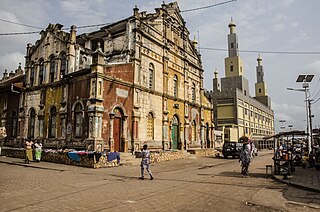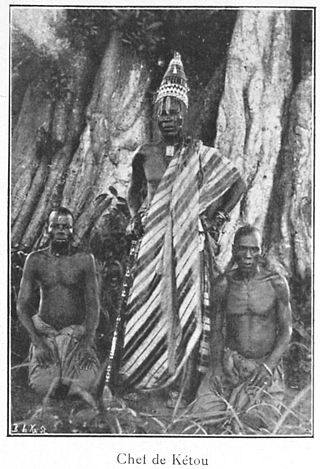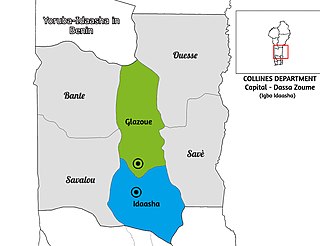
Benin, officially the Republic of Benin, and formerly Dahomey, is a country in West Africa. It is bordered by Togo to the west, Nigeria to the east, Burkina Faso to the north-west, and Niger to the north-east. The majority of its population lives on the southern coastline of the Bight of Benin, part of the Gulf of Guinea in the northernmost tropical portion of the Atlantic Ocean. The capital is Porto-Novo, and the seat of government is in Cotonou, the most populous city and economic capital. Benin covers an area of 114,763 square kilometres (44,310 sq mi) and its population in 2021 was estimated to be approximately 13 million. It is a small, tropical country. It is one of the least developed, with an economy significantly dependent on agriculture, and is an exporter of palm oil and cotton. Some employment and income arise from subsistence farming.

The Kingdom of Dahomey was a West African kingdom located within present-day Benin that existed from approximately 1600 until 1904. It developed on the Abomey Plateau amongst the Fon people in the early 17th century and became a regional power in the 18th century by expanding south to conquer key cities like Whydah belonging to the Kingdom of Whydah on the Atlantic coast which granted it unhindered access to the tricontinental triangular trade.

Porto-Novo is the capital and second-largest city of Benin. The commune covers an area of 110 square kilometres (42 sq mi) and as of 2002 had a population of 223,552 people.

Béhanzin is considered the eleventh King of Dahomey, modern-day Republic of Benin. Upon taking the throne, he changed his name from Kondo.

The Fon people, also called Fon nu, Agadja or Dahomey, are a Gbe ethnic group. They are the largest ethnic group in Benin found particularly in its south region; they are also found in southwest Nigeria and Togo. Their total population is estimated to be about 3,500,000 people, and they speak the Fon language, a member of the Gbe languages.
The Aja also spelled Adja are an ethnic group native to south-western Benin and south-eastern Togo. According to oral tradition, the Aja migrated to southern Benin in the 12th or 13th century from Tado on the Mono River, and c. 1600, three brothers, Kokpon, Do-Aklin, and Te-Agbanlin, split the ruling of the region then occupied by the Aja amongst themselves: Kokpon took the capital city of Great Ardra, reigning over the Allada kingdom; Do-Aklin founded Abomey, which would become capital of the Kingdom of Dahomey; and Te-Agbanlin founded Little Ardra, also known as Ajatche, later called Porto Novo by Portuguese traders and the current capital city of Benin.

The King of Dahomey was the ruler of Dahomey, an African kingdom in the southern part of present-day Benin, which lasted from 1600 until 1900 when the French Third Republic abolished the political authority of the Kingdom. The rulers served a prominent position in Fon ancestor worship leading the Annual Customs and this important position caused the French to bring back the exiled king of Dahomey for ceremonial purposes in 1910. Since 2000, there have been rival claimants as king and there has so far been no political solution. The Palace and seat of government were in the town of Abomey. Early historiography of the King of Dahomey presented them as absolute rulers who formally owned all property and people of the kingdom. However, recent histories have emphasized that there was significant political contestation limiting the power of the king and that there was a female ruler of Dahomey, Hangbe, who was largely written out of early histories.

Dassa-Zoumé, also known as Igbó Ìdàáshà or simply Dassa, is a city in central Benin, on the Cotonou-to-Parakou railway and the main north-south highway. It is the capital of Collines Department. The commune covers an area of 1,711 square kilometres (661 sq mi), and as of 2013 had a population of 112,118.

The Oyo Empire was a Yoruba empire in West Africa. It was located in present-day southern Benin and western Nigeria. The empire grew to become the largest Yoruba-speaking state through the organizational and administrative efforts of the Yoruba people, trade, as well as the military use of cavalry. The Oyo Empire was one of the most politically important states in Western Africa from the mid-17th to the late 18th century, and held sway not only over most of the other kingdoms in Yorubaland, but also over nearby African states, notably the Fon Kingdom of Dahomey in the modern Republic of Benin on its west.
Ketu is the name of a Yoruba subgroup, historical kingdom and region straddling parts of what is now southeastern Republic of Benin and parts of southwest Nigeria. The chief town and traditional capital of the area was the town of Kétou (Kétu), which is considered to be one of the oldest capitals of the Yoruba-speaking people, tracing its establishment to a settlement founded by a descendant of Oduduwa called Sopasan or Soipasan. The Oba of the town were traditionally styled "Alákétu", and are related directly to Ile-Ife in present-day Nigeria. Other towns that were historically part of the Kétu Kingdom are;

Kétou is a Yoruba town, arrondissement, and commune located in the Plateau Department of the Republic of Benin. The commune covers an area of 2183 square kilometres and as of 2013 had a population of 156,497 people, making it the 13th largest settlement in Benin.

The following outline is provided as an overview of and topical guide to Benin:
Benin, officially the Republic of Benin, is a country in Western Africa. It borders Togo to the west, Nigeria to the east and Burkina Faso and Niger to the north; its short coastline to the south leads to the Bight of Benin. Its size is just over 110000 km2 with a population of almost 8500000. Its capital is the Yoruba founded city of Porto Novo, but the seat of government is the Fon city of Cotonou. About half the population live below the international poverty line of US$1.25 per day.
The Kingdom of Ardra, also known as the Kingdom of Allada, was a coastal West African kingdom in southern Benin. While historically a sovereign kingdom, in present times the monarchy continues to exist as a non-sovereign monarchy within the republic of Benin.
Egba Kotan II is the king of the Yoruba State of Dassa in central Benin. The king rose to the throne on March 3, 2002.

The Idaasha also spelt Idaaca, Idaaṣa and Idaaitsa are a group of the Yoruba people, situated in the central portions of the Collines Department of Benin, West Africa. They are based in and around the communities of Glazoué and Dassa both situated west of the Oueme River. Every year, the Idaasha organize a festival of arts and culture known as FACI to celebrate their culture and heritage, themed Àshà Ìbílẹ̀.










